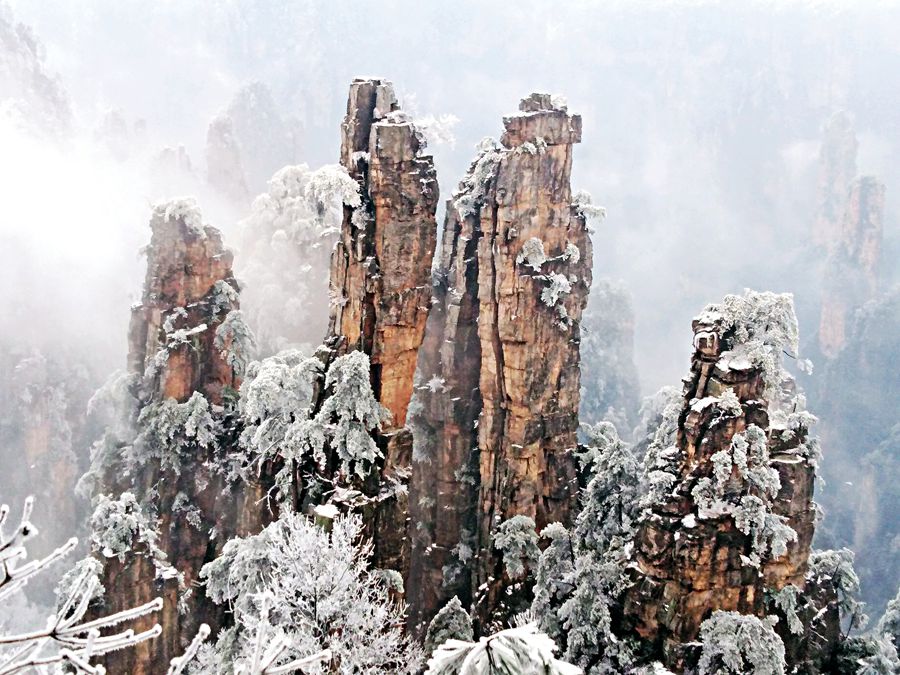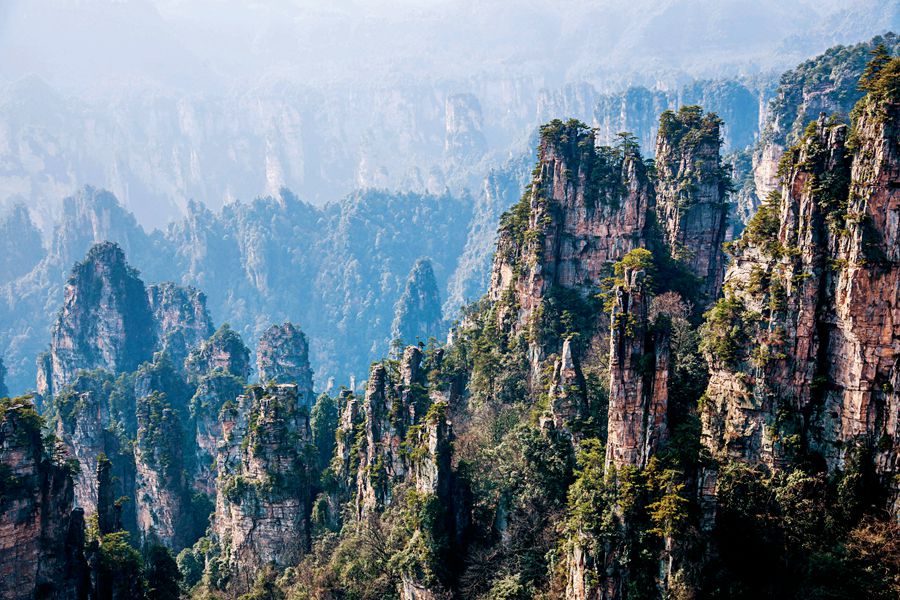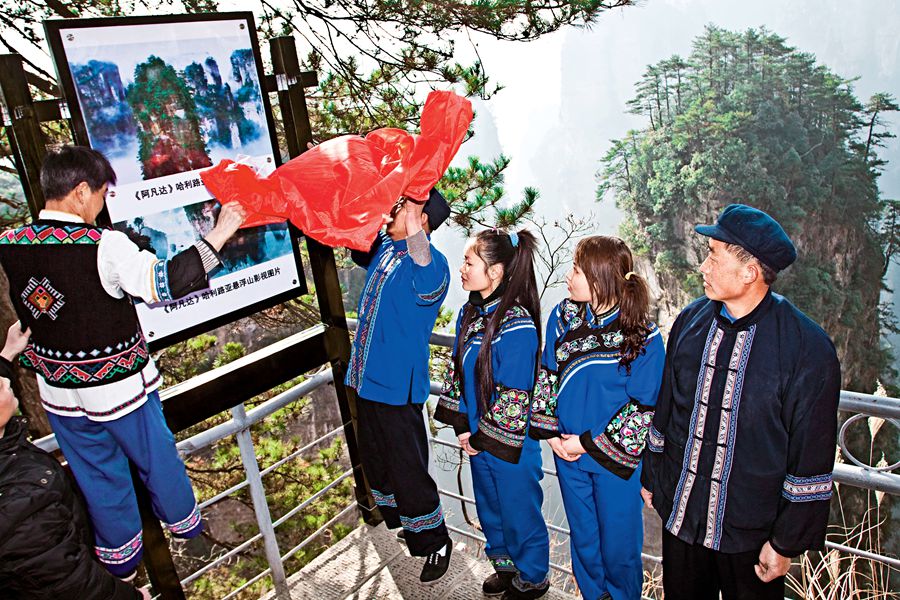IN southwest China’s Hunan Province lies a scenic area that is unique in the world for its rare rock forests, rock formations, and untarnished natural scenery. This area is called Wulingyuan Scenic and Historic Interest Area, and consists of Zhangjiajie National Forest Park, Suoxiyu Nature Reserve, Tianzi Mountain Nature Reserve, and the newly-added Yangjiajie Scenic Area, covering an overall area of 500 square km.

Rime, icicles, and a sea of clouds on the snow covered peaks in the Zhangjiajie Tianzi Mountain Nature Reserve, a World Natural Heritage Site.
The various forms of natural scenery in Wuling- yuan include rugged stone columns, peaks, and ridges, and steep cliffs. In addition, there are various kinds of old trees, cloud and fog formations, gurgling springs and surging waterfalls. Animal lovers may also be lucky to spot some of the many rare birds, mammals, and endangered animals that live in the area. The natural beauty found here is one of nature’s masterpieces, captivating the senses with the sounds and colors of its creation. With the local subtropical rains and mild temperatures, lush vegetation thrives here. In December 1992, the Wulingyuan Scenic and Historic Interest Area was inscribed on the UNESCO World Heritage Site list.
Multitudinous Rock Formations
Wulingyuan is famous for its more than 3,000 spiky sandstone pillars and sandstone peaks, most of which stand higher than 200 meters, forming the rarest forest of quartzite sandstone pillar formations in the world.
The geological structure of the region belongs to the neocathaysian structural third uplift-belt. Over 70 million years ago, the orogenesis movement instigated an upheaval and separation of the flat quartzite sandstone substratum, which finally formed the unified gorge. The unique and natural formations of the quartzite sandstone peak forest which we see today is a result of the combination of long-term fluvial erosion of the surface of the formation, biochemical effects of gravitational collapse, and weather conditions. The peaks range in height from several meters to over 400 meters, distributed over an area with an altitude of 500 to 1,100 meters. The various shapes of the sandstone forest inspire onlookers with limitless associated mental images, from people and celestial beings to monsters and wild beasts.

Shentang Gulf Area in the Zhangjiajie National Forest Park, Hunan Province.
According to a legend of the Tujia people, a local ethnic minority group in the region, the special formation of the sandstone peaks is connected with a man named Xiang Dakun in ancient times. As the legend goes, Xiang was dissatisfied with the government at that time. As a result, he raised his own standard and proclaimed himself king of the region of Tianzi Mountain, promising to create a peaceful world. When the emperor heard this, he sent his troops to suppress the uprising of the self-proclaimed king. After being besieged in the mountains several times without success, Xiang finally ended his life by leaping into a ravine together with his subordinates, and their bodies turned into the peaks seen in the valley today. Toward the southeast of the region, there is a deep valley which has more than 30 rugged shaped rock peaks in it. Local people say that those peaks were the king’s army. The boulder which stands out among the peaks is said to be the King Xiang, and the other peaks are his soldiers.
There is also another stone peak called “Old Man Picking Herbs” because the figure of the rock formation looks like an elderly Tujia man wearing a traditional head dress, carrying a basket full of herbs on his back. The legend says that he was once a doctor to the king’s army, known for his knowledge of herbs and medical skills. The day he came back from the mountain and heard the news of Xiang’s defeat and death, he was so disheartened that he turned into a stone peak.
Wulingyuan is surrounded by abrupt stone peaks and various layers of mountains. Whenever the sun comes out after the end of a rain shower or period of drizzling rain, a rainbow can be seen stretching across the valley. Light pierces through the sea of clouds into the valley, and the stone peaks poke their heads through the clouds. In the Hollywood blockbuster movie Avatar, many of Pandora’s prototypes were inspired by the giant quartzite sand rock pillars. The floating peaks of the Hallelujah Mountains are rendered from one soaring stone peak dubbed Pillar between Heaven and Earth.
Home to Rare Animals and Plants
Wulingyuan is a treasure trove of flora and fauna. In addition, with its mild climate, abundant rainfall, and flourishing forests, the environment helps in the survival and reproduction of many species. With the remoteness of the Wulingyuan area, transportation is not convenient and local residents are few, thus reducing human disturbance of the local ecosystem. This has done much to preserve the diversity of biological resources and form a well-structured and complete ecosystem, which has been very valuable for scientific research.

The name of the sand rock pillar in the Zhangjiajie National Forest Park known as “Pillar between Heaven and Earth” was officially changed to Floating Hallelujah Mountain from the movie Avatar on January 25, 2010.
In the area, there are some very remote places, one of which is the rather mysterious Shentang Gulf in the Tianzi Mountain. This gulf lies in the middle of a remote open valley surrounded by soaring precipices on all sides, with water so deep that its depth is unknown. Every year, the valley of the Shentang Gulf is filled with winds and rain sometimes bringing with it the faint sounds of gongs, beating of drums or human and animal voices making it a place of mystery.
To reach the Shentang Gulf, you have to climb up a very steep ladder, each rung only big enough to support one foot. Local people say that the higher you climb, the scarier it gets. Consequently, few people make the effort to travel there.
Heicong Hilltop is another sealed-off place in Wulingyuan, which is named after the dense fir forest. It has been untouched since ancient times and is only visited by wild animals.
Among the plants that grow there, the wuling pine is the most widely distributed among the diverse species of trees. The locals say, “Wulingyuan has 3,000 peaks, and among the peaks there are tens of millions of pines.”
In addition to pines, there are also many old trees in the region, dubbed living relics characterized by their antiquity, uniqueness, and quantity. For example, in Zhangjiajie Village, there is an ancient ginkgo tree that stands 44 meters high, with a trunk diameter of 1.59 meters, known as the living fossils in nature.
These plant germplasm resources have significant scientific value, and their living environment, forest structure, protection and preservation all have important research value. According to a general investigation, 116 species of terrestrial vertebrates from 50 families are found in the Wulingyuan area. In addition, it is home to the South China tiger, clouded leopard, macaque, giant salamander, civet cat, and countless other wild animals. Giant salamanders can be frequently found in streams, springs, and pools. To study the role of animal ecology in the Wulingyuan ecosystem and the relationship between them is of great scientific value in the work of protecting animals and maintaining ecological balance.
China’s First 5A-Class Tourist Attraction
The Wulingyuan Scenic Area was a newly-discovered region in the early 1980s. In 1982, China’s State Council approved the construction of its first national forest park – Zhangjiajie National Forest Park, which was included in the first list of 5A-class tourist attractions.
The Zhangjiajie National Forest Park is rich with plants and wildlife, having a forest coverage rate of 98 percent. It is called a “natural museum and natural botanical garden,” forming a natural ecosystem. There are many scenic spots in the area, of which the most well-known ones are Huangshi Village, Shadao Ravine, Gold Whip Cliff, and Gold Whip Creek. In the core scenic area, the 5,710-meter-long Gold Whip Creek is one of the most beautiful sights to see.
The Suoxiyu Scenic Spot is named after the overall appearance of the many bodies of water that crisscross the valley like a rope, prompting the locals to call the valley “thousands of peaks, and hundreds of bodies of water.” In the mountainous region, ravines, canyons, streams, ponds, and waterfalls can be seen everywhere, a perfect example of natural harmony. The Baipu Creek is the most spectacular sight in Suoxiyu. Here visitors can see a proliferation of waterfalls along with more than 100 large limestone caves, over a dozen of which are open to the public. The most distinctive is the Huanglong Cave, also known as the “underground pearl.” The Huanglong Cave is 7.5 kilometers long, and is divided into four layers. There is a large hall in the ravine, with a river running through it. It is majestic, making it one of the most famous tourist attractions in Wulingyuan.
The Tianzi Mountain Scenic Area is located in the northern part of Wulingyuan. Its mountain ranges and rivers are connected with Zhangjiajie National Forest Park and Suoxiyu Nature Reserve, and have been called the territory of untouched beauty. From the top of the mountain, visitors can see the many layers of mountain ranges and flora as far to the horizon. This mountain region boasts an elevated agricultural terrace more than 1,000 meters high, and has been ranked as one of the highest terraces in China. The platform rises abruptly into the air, with three sides slightly more uplifted than the other. There are cultivated rice terraces on top of a very deep valley. The land has been cultivated and maintained by a small group of local farmers for centuries. To reach this area, the route is filled with uneven roads, making it accessible only by foot after at least two hours of hiking. As a result, residents here have very little contact with the outside world and rarely venture beyond the border of their mountain.
The Yangjiajie Scenic Area is the sister mountain to Zhangjiajie, being connected to Zhangjiejie in the eastern section, and Tianzi Mountain in the north. The mountains and waters here are so beautiful that you feel like you have walked into the studio of a master artist. It has been said that the family of a military general in ancient China by the family name of Yang once set up camp here for a period of time. Today a “Yang family tree” still remains, as well as a Yang family cemetery. Many spots are also named after the general’s family by descendants in memory of their ancestors.
This scenic area is divided into the following three main excursion areas: Xiangzhi Stream, Longquan Gorge, and the Hundred Monkey Valley. The Xiangzhi Stream has high mountain peaks with great views, deep expanses of water, quaint walking paths, and stunning terraced fields on high elevated peaks. The Longquan Gorge is surrounded by cliffs, serving as natural walls on both sides, protecting it like an ancient strongly-barricaded city. The Hundred Monkey Valley is home to monkeys and egrets. Bands of macaques romp about between cliffs and ravines, while flocks of egrets rest among the trees.


